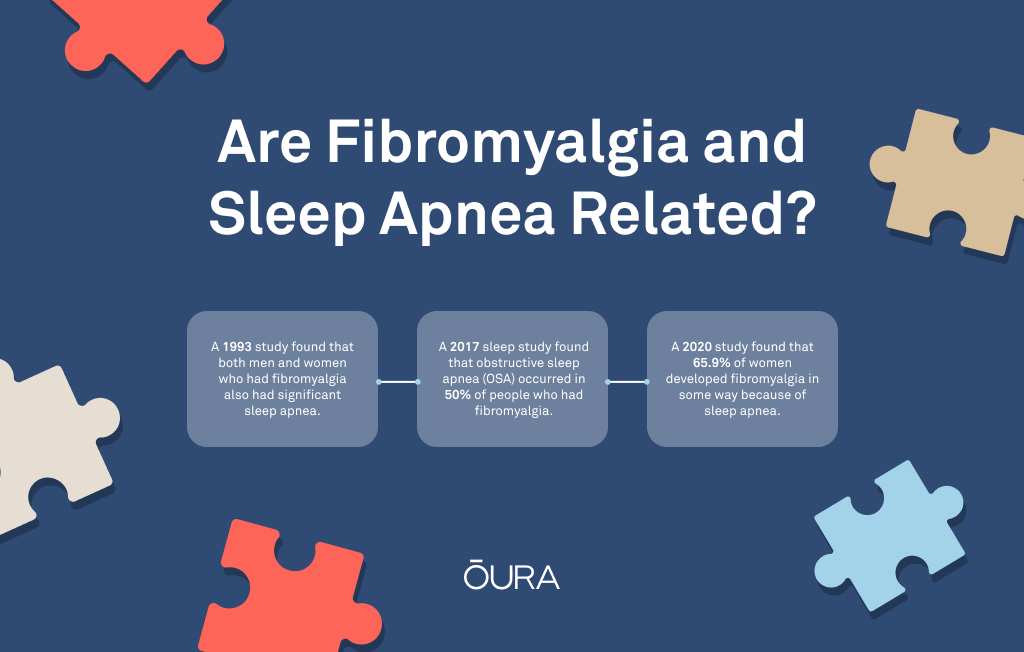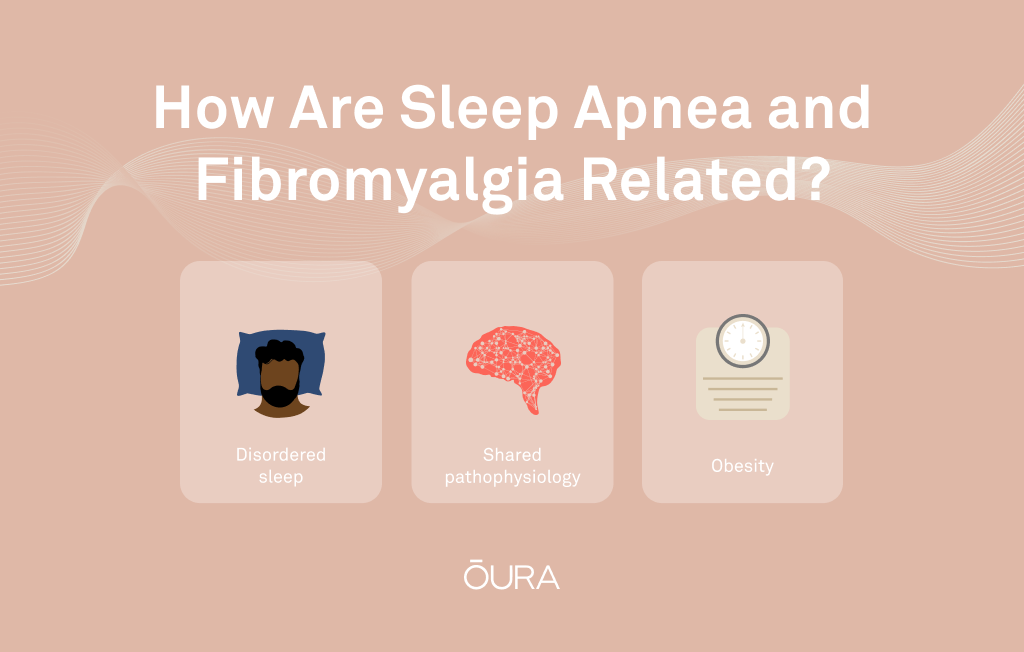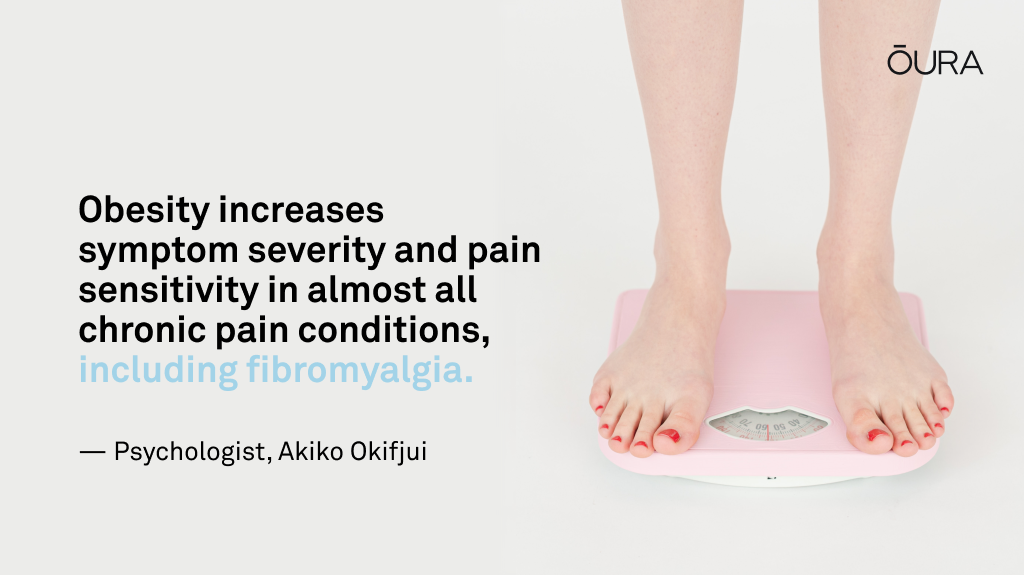Fibromyalgia, a chronic condition characterized by widespread musculoskeletal pain, and sleep apnea, a sleep disorder causing interrupted breathing, affect a significant percentage of the U.S. adult population. About 30 million people experience sleep apnea, while 4 million are affected by fibromyalgia. Both conditions are often associated with sleep disturbances.
Although Oura is not a diagnostic tool, it can provide valuable insights into your sleep quality with the detailed metrics available in your Sleep Score. It can also highlight potential disturbances like restlessness and increased wake time. Similarly, people with fibromyalgia may find that biosignals such as heart rate variability (HRV) and resting heart rate are affected by their condition.
RELATED: How Oura Can Help Monitor Sickness
While it may appear that the only two factors connecting sleep apnea and fibromyalgia are their lack of a cure and the negative impact on sleep, researchers have discovered a more solid bidirectional link between them.
The Relationship Between Fibromyalgia and Sleep Apnea: What the Research Says
Sleep apnea can be caused by a number of risk factors, including conditions such as fibromyalgia and restless leg syndrome. On the other hand, if you have fibromyalgia, there is a chance you will also have sleep apnea. Several studies have established this link between the two conditions.
A 1993 study published in the American Journal of Medicine found that both men and women who got a new diagnosis of fibromyalgia also had significant sleep apnea. Almost two decades later, further research labeled sleep apnea in fibromyalgia patients ‘a growing concern.’ This study discovered that fibromyalgia patients have a tenfold increase in sleep-disordered breathing, which includes obstructive sleep apnea.
A 2017 sleep study found obstructive sleep apnea (OSA) occurred in 50% of people who had fibromyalgia. Following this in 2020, a study to find the relationship specifically between women with fibromyalgia syndrome and obstructive sleep apnea concluded that 65.9% of women developed the former in some way because of the latter.

These are important findings as they show that there is some form of correlation between the two disorders. However, while evidence is ever-growing, it’s not possible to completely determine the bidirectional relationship between fibromyalgia and sleep apnea. This is because of the following reasons:
- Variation of symptoms: People’s experiences can vary drastically, from the type of fibromyalgia symptoms they experience to their severity and frequency. This makes drawing conclusions from the data and studies surrounding the relationship with sleep apnea particularly difficult.
- Sleep apnea is heterogenous: There are multiple different subtypes of the disorder, like central sleep apnea and obstructive sleep apnea, meaning these different categories may have a different relationship with fibromyalgia.
That said, researchers have been able to draw some tentative conclusions about the link between sleep apnea and fibromyalgia.
RELATED: The Surprising Link Between Menopause and Sleep Apnea
How Are Sleep Apnea and Fibromyalgia Related?
The bidirectional relationship sleep apnea has with fibromyalgia means that one can cause the other and vice versa. Alongside this, symptoms of one condition can be exacerbated by the other. But why is this? There are a few possible explanations.

Disordered Sleep
Both fibromyalgia and sleep apnea can cause sleep problems. This can make symptoms like fatigue, brain fog, and depression worse. Lack of sleep can also decrease your pain threshold, making chronic pain worsen.
Shared Pathophysiology
Pathophysiology refers to the impact a disorder or injury has on the functions of the body. In fibromyalgia, levels of neurotransmitters that facilitate pain transmission are increased in the brain and spinal cord, whereas sleep apnea has been found to increase the levels of neurotransmitters called glutamate.
Imbalanced neurotransmitter levels can cause numerous health issues, including damage to nerve cells and the brain, inflammtion, stress and anxiety, muscle weakness, and sleep disturbances. All of these can worsen sleep apnea and fibromyalgia.
Obesity
Obesity is a shared risk factor for both sleep apnea and fibromyalgia. Psychologist Akiko Okifjui, Ph.D., a researcher in the Pain Management Center at the University of Utah, found that “obesity increases symptom severity and pain sensitivity in almost all chronic pain conditions, including fibromyalgia.”

Similarly, fat deposits can narrow the airways, increasing airway pressure and decreasing muscle activity, which results in obstructive sleep apnea. These links mean that people who suffer from obesity are more likely to develop both fibromyalgia and sleep apnea.
READ MORE: How Sleep Helps With Weight Management
How to Manage Sleep Apnea and Fibromyalgia
As you can imagine, managing the combination of fibromyalgia and sleep apnea can be challenging, but several strategies can help improve your quality of life. It’s important to be proactive in finding a solution that works, as sleep apnea can cause other medical issues like low blood pressure and heart disease, while fibromyalgia can cause rheumatoid arthritis and severe sleep disturbances.
If possible, a good first step to managing the two conditions is to undergo a sleep study called polysomnography to diagnose the disorder. You can also try out the following tips:
- Get treatment: An effective way to manage fibromyalgia and sleep apnea is to get treatment. This can involve working with a team of healthcare professionals, such as a sleep specialist and a rheumatologist, to develop a personalized treatment plan that addresses your specific symptoms and needs. This step is particularly important as symptoms can range drastically from patient to patient, and what seems to work for other people may not necessarily work for you.
- Develop good sleep habits: Good sleep habits can help improve sleep quality and reduce symptoms of both fibromyalgia and sleep apnea. This may involve creating a relaxing bedtime routine, avoiding caffeine and alcohol in the evening, and keeping a consistent sleep schedule. Oura members can use Tags to track how their habits and lifestyle changes impact their sleep quality. The insights can prove invaluable for optimizing sleep habits.
- Consider assistive devices: Assistive devices, such as a CPAP treatment machine or a specialized mattress can help improve sleep quality and reduce symptoms of sleep apnea and fibromyalgia.
- Seek support: Alongside professional support from a medical team, it’s important to have a good support system in place made up of friends and family. Additionally, counseling or therapy can help you cope with the emotional aspects of dealing with sleep apnea and fibromyalgia.
- Practice stress management: Stress can exacerbate symptoms of both fibromyalgia and sleep apnea. Therefore, practicing stress management techniques, such as mindfulness meditation or deep breathing exercises, can help reduce incidences of stress and improve symptoms. As an Oura member, you can use the Explore Tab to access a growing library of guided and unguided meditation audio sessions. Additionally, the Oura App provides biofeedback data after each session to help you determine the type of meditation that works best for you.
READ MORE: 10 Simple Breathing Exercises for Relaxation
Managing the pain associated with conditions like fibromyalgia and sleep-disordered breathing is a process, and you may not find the right combination of treatments straight away. As such, it’s crucial to be patient with yourself, and you shouldn’t hesitate to seek help when you need it.
A great way to start regaining control over the pain and discomfort is to monitor your sleep patterns. This way, you can keep track of your sleep quality and hours, as well as any habits or choices that may be impeding your progress toward better health.
Oura member Lewis C. found that being able to track sleep and lifestyle habits helped him manage his autoimmune disease. “Thanks to tools like Oura Ring, I got my sleep back on track, identified what was wrong, and began making the necessary lifestyle changes to heal,” he says.
RELATED: What Makes the Oura Ring Different?
The Oura Ring is not a medical device and is not intended to diagnose, treat, cure, monitor, or prevent medical conditions or illnesses.










